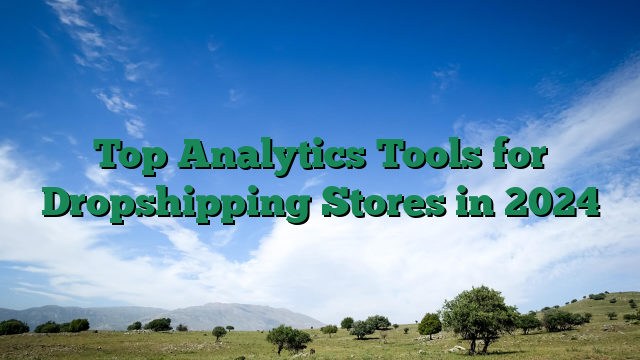Top Analytics Tools for Dropshipping Stores in 2024
Introduction
Running a dropshipping store can feel like navigating a maze blindfolded. You’ve got products, traffic, and sales, but are you truly maximizing your profits? The secret lies in analytics tools. These tools are your compass, guiding you through the chaos of data to uncover actionable insights.
In 2024, the right analytics tools can mean the difference between a struggling side hustle and a thriving online business. Whether you’re tracking customer behavior, monitoring profit margins, or optimizing ad spend, these tools are your ticket to data-driven success.
Let’s dive into the top analytics tools for dropshipping stores and explore how you can use them to grow your business—and even turn your newfound skills into a profitable side hustle.
1. Google Analytics Setup: Your Foundation for Data-Driven Decisions
Why Google Analytics is a Must-Have
Google Analytics is the Swiss Army knife of analytics tools. It’s free, powerful, and integrates seamlessly with most e-commerce platforms. But here’s the catch: most dropshippers don’t use it to its full potential.
Step-by-Step Setup Guide
- Create a Google Analytics Account: If you don’t already have one, sign up at .
- Install the Tracking Code: Add the tracking code to your website. Most platforms like Shopify or WooCommerce have built-in integrations.
- Set Up Goals: Define what success looks like. For example, track completed purchases, add-to-cart actions, or newsletter sign-ups.
- Enable E-Commerce Tracking: This feature lets you monitor sales performance, product revenue, and customer behavior.
Real-World Example
Sarah, a dropshipper selling eco-friendly products, used Google Analytics to discover that 70% of her traffic came from mobile devices. She optimized her store for mobile users, resulting in a 25% increase in conversions.
2. Profit Tracking Dashboards: Know Your Numbers
The Importance of Profit Tracking
Profit tracking is the backbone of any successful dropshipping business. Without it, you’re flying blind. Tools like Shopify Analytics and ProfitWell can help you monitor revenue, expenses, and profit margins in real time.
Top Tools for Profit Tracking
- Shopify Analytics: Built into Shopify, this tool provides detailed reports on sales, customer behavior, and marketing performance.
- ProfitWell: Ideal for subscription-based dropshipping models, it offers advanced metrics like churn rate and customer lifetime value.
- QuickBooks Online: Perfect for tracking expenses and generating financial reports.
Actionable Tips
- Set Up Automated Reports: Save time by scheduling weekly or monthly reports.
- Monitor Key Metrics: Focus on gross profit, net profit, and return on ad spend (ROAS).
- Use Benchmarks: Compare your performance to industry averages to identify areas for improvement.
Monetization Potential
Mastering profit tracking can open doors to consulting opportunities. Offer your expertise to other dropshippers struggling with their numbers.
3. Customer Behavior Analysis: Turn Data into Sales
Why Customer Behavior Matters
Understanding your customers is the key to boosting sales. Tools like Hotjar and Kissmetrics provide insights into how users interact with your store.
Tools for Customer Behavior Analysis
- Hotjar: Visualize user behavior with heatmaps, session recordings, and surveys.
- Kissmetrics: Track individual customer journeys to identify patterns and optimize your funnel.
- Crazy Egg: Similar to Hotjar, it offers heatmaps and A/B testing features.
Step-by-Step Optimization
- Analyze Heatmaps: Identify where users click, scroll, and drop off.
- Conduct A/B Tests: Test different layouts, CTAs, and product descriptions.
- Segment Your Audience: Tailor your marketing efforts based on customer demographics and behavior.
Real-World Example
Mike, a dropshipper selling fitness gear, used Hotjar to discover that users were abandoning their carts at the shipping page. By offering free shipping for orders over $50, he increased his conversion rate by 15%.
Conclusion
Key Takeaways
- Google Analytics is your foundation for data-driven decisions.
- Profit tracking dashboards ensure you’re maximizing your profits.
- Customer behavior analysis helps you optimize your store for higher conversions.
Monetization Potential
The skills you gain from mastering these analytics tools can be monetized in multiple ways:
– Offer consulting services to other dropshippers.
– Create and sell online courses or eBooks on analytics for e-commerce.
– Build a blog or YouTube channel sharing tips and tutorials.
Your Next Steps
Ready to take your dropshipping business to the next level? Join TheBizWizAcademy.com, where you’ll find step-by-step courses, a supportive community, and expert guidance—all for less than your daily coffee.
Remember, the right analytics tools aren’t just about tracking numbers—they’re about turning data into dollars. Let’s make it happen!
External Resource: For more insights on analytics tools, check out this .
🚀 Want to level up your online business? Join TheBizWizAcademy and start Networking and Learning!
